German defense in the Berlin direction
The fighting unfolded during the Berlin operation in Western Pomerania, Mecklenburg, Brandenburg and parts of the provinces of Saxony. The terrain of the offensive line of the 2 and 1 of the Belarusian, 1 of the Ukrainian fronts for the most part was convenient for the operation of all military branches. On the other hand, natural and anthropogenic factors allowed to create a strong defense. There were a large number of rivers, lakes, canals, large forests, large cities and settlements with strong stone structures, which provided ample opportunities for organizing defense in a short time. For the advancing fronts, this created additional difficulties for the deployment of troops and their maneuver.
The Soviet command had to take into account the need to force a significant number of water obstacles. The main part of the rivers in central Germany flows in the meridional direction from south to north. This gave the Germans additional opportunities to organize defensive positions on the western banks of the rivers. The most serious water obstacles were the Oder River and its branches (Eastern and Western Oder), Neisse, Spree, Havel and Elbe, as well as Finov, Hohenzollern, Ruppiner, Oder - Spree and Teltow canals.
Back in January 1945, when the Red Army broke through the Vylensky defensive line, the German command hastily began to equip defensive positions on the territory of the Reich. Especially fortification works were launched in February, when our troops reached the line of the Oder and Neisse rivers. The central districts of Germany and the imperial capital were threatened. Engineering works were not only troops and paramilitary organizations, they mobilized the German population, attracted a large number of prisoners of war and foreign workers, a significant number of which worked in Germany throughout the war.
Particular attention was paid to creating a solid defense on the west bank of the Oder and Neisse. The Germans here created a solid and deeply echeloned defense. Oder-Neysen defensive line had three lanes: the first (main), second and third (rear). On important directions between these strips, intermediate and cut-off strips were constructed. The depth of the German defense at the Oder-Neisen line reached 20-40 kilometers. The total depth of the German defense in the Berlin area, including the Berlin fortified area, reached 100 kilometers.
The main line of enemy defense mainly passed along the western bank of the Oder and Neisse rivers. In addition, in the area of Frankfurt an der Oder, Guben, Forst and Muskau, the Germans had a small bridgehead on the east bank. The first band consisted of 2-3 position, which reached a total depth of 5-10 km. The front edge was covered with wire barriers and minefields. All settlements in this lane were turned into strong points. The dense network of fortifications was a serious obstacle for our troops. The Germans, using a system of locks on the Oder and numerous channels, produced a number of areas to flooding that had to delay the advance of our troops.
The Germans created a particularly powerful defense in the possible directions of attack of the shock factions of the Soviet fronts: sections from Stettin to Schwedt (2 of the Belorussian Front), from the mouth of the r. Alter Oder Frankfurt (1-th BF) from Guben (Gubin) to Pribusa. The area from Stettin to Schwedt was particularly difficult in terms of nature for the advancing troops. Here the river Odra (Oder) has two arms, which created two independent rivers: Ost (East) and West Oder (West) Oder. The main line of defense of the German troops passed along the western bank of the West Oder. The floodplain of the river and the interfluve were flooded and were under enemy fire. In order to attack the enemy, it was necessary to force the East and West Oder under German fire.
The Germans created the most powerful engineering defense in the Kyustrin-Berlin sector, in the sector of the front from the r. Alter Oder to Frankfurt an der Oder. Here the enemy had a full profile trench line 3-4. On the Frankfurt-on-Oder-Pribus section, nature also did not contribute to the actions of large forces. The German defense passed through a wooded-lake area, so the enemy built a line of intermittent trenches 1-3, covering the most accessible areas. On the offensive site of the 1 of the Ukrainian Front, Guben-Pribus, the Germans had a dense defense with 2-3 full-profile trench lines.
German cities were prepared for all-round defense and street fighting. As a result, settlements have become strong points of defense. The approaches to them covered several lines of trenches. Special attention was paid to the eastern and southern sectors of defense. The most powerful defense units were Stettin, Schwedt, Frankfurt, Guben, Forst and Muskau. These cities, in connection with other strong points, were the basis of the main line of defense. A particularly powerful defense was created in Frankfurt an der Oder. Roads that passed through forests were closed with debris, mined. Much attention was paid to anti-tank defense. To do this, they tried to use natural frontiers (rivers, canals), made blockages, set up many minefields. On the most important directions on the 1 km of the front accounted for up to 2 thous. Min. Ahead of the first trench, rifle cells for soldiers armed with anti-tank grenade launchers (faust-cartridges) were arranged at road junctions.
The leading edge of the second line of defense was held in 10-20 km from the leading edge of the main line. The second line of defense was on the west bank. Randov, settlements of Angermünde, Vritzen, Seelow, Katlov, Debern, Weiswasser and Goerlitz. The most powerful defense was in the Berlin direction. Here was the 2-3 line of trenches, all settlements and even individual estates, estates (folvarki) were prepared for the perimeter defense, turned into strong points. The most famous position in the second lane of defense was the Seelow Heights in the Kustrin-Berlin direction. The city of Seelow and the Seelow Heights were one of the main obstacles to our troops in Berlin.
The Seelow Heights are the high bank of the old channel of the Oder and rise 40-50 meters above the terrain. The steepness of the coast reaches 30-40 degrees. From these heights it was good to adjust the fire of mortars and artillery. On the slopes of the heights were located firearms. On the slopes of the trenches and trenches. Before them are anti-tank ditches. Overcome the steep slopes of the Zeelov Heights Tanks and self-propelled guns could only on the roads. However, all roads were mined and shot from all types weapons. For our troops, the location of the German troops was difficult to identify because of the groves and gardens east of Seelow. The Germans Seelow Heights called "the castle of Berlin." Indeed, after the heights opened a direct path to the German capital. The Germans were preparing to stand to the death in this position.
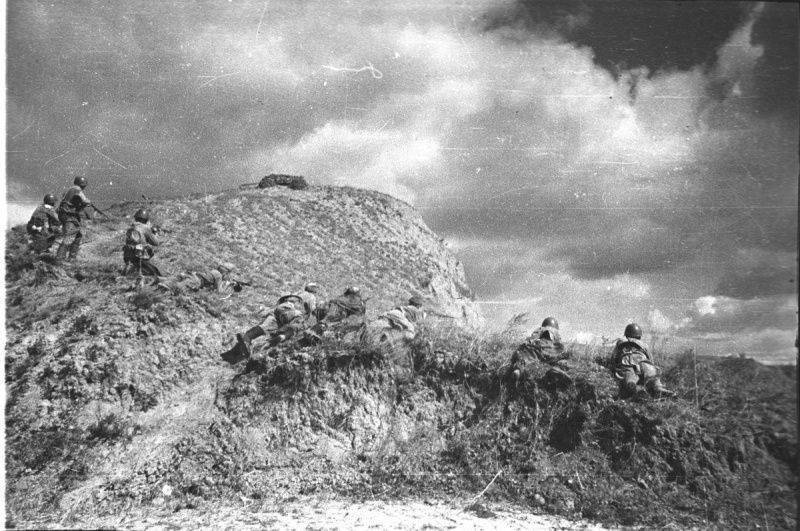
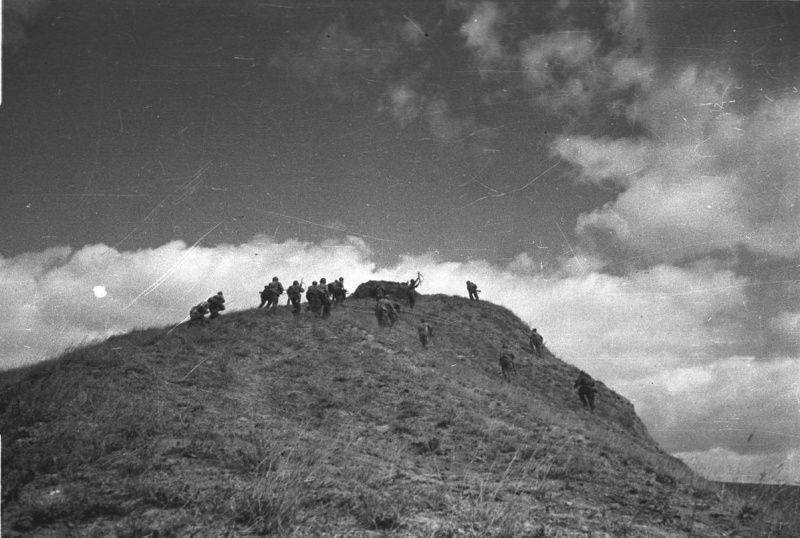
Attack by Soviet troops of Seelow Heights
The section of the second German defense line from Katlov to Weiswasser in front of the 1-th Ukrainian Front (the “Matilda line”) consisted of a single trench and settlements prepared for defense. The terrain was wooded, so the Germans used a wide range of trees here. The section from Müllrose to Katlova passed through a wooded lake area and consisted of a discontinuous trench and separate strongholds. On the roads, positions for artillery and anti-tank grenade launchers were equipped.
The rear line of defense was in 20-40 km from the front edge of the main line. She walked from Torgelov, along the Ikker River, through Pasewalk, Prenzlau, Eberswalde, Batslov, Müncheberg, Fürstenwalde, along the western bank of the Spree to the lake in the Beskov area, through the Ferov, again along the western shore of the Spree, Cottbus and Spremberg. The basis of the rear line of defense were cities, turned into powerful strongholds and resistance nodes. They were ringed in trenches. The most important strongholds were Torgelov, Prenzlau, Eberswalde, Batslov, Müncheberg, Fürstenwalde, Beskov, Cottbus and Spremberg.
Most densely, the third defense zone was prepared in the central (Berlin) direction, in the Eberswalde-Fürstenwalde sector and in the Cottbus-Berlin direction, in the Cottbus-Spremberg sector. For example, Cottbus had two defensive lines, strong artillery and armored caps were located in the most important directions. The trenches were covered with wire and anti-tank barriers. The sturdy stone buildings were turned into long-term fortifications, and the streets were barricaded. In much the same way other cities were prepared for defense. All the main forces of the field army defended the first and second line of defense, therefore, the sapper units, the militia and the Hitler Youth were located on the rear line.
Simultaneously with the equipment of the Oder-Neisen defensive line, the Germans quickly prepared the Berlin district for defense. The Berlin defensive area consisted of three annular defensive lines (external, internal and urban). It was a whole fortified area, prepared for long battles. The German capital was surrounded on all sides by rivers, canals, lakes and forests, which helped create a defensive area. Rivers and canals divided Berlin into several parts, which also increased the defensive capabilities of the German garrison. The entire Berlin defensive area was divided into nine sectors. In the center was located sector No. 9, from which the remaining eight defense sectors radially diverged. Each sector, in turn, was divided into several subsectors.
The outer defensive bypass of the Berlin district was located in 25-40 km from the center of the capital along the line Biesenthal, lake Stinitz-see, lake Zeddin-see, Mittenwalde, Rangsdorf, Tire, lake Schwilow-see, Brieselang, Velten and Lanka. Numerous rivers, lakes and canals strengthened the defense. The settlements were turned into knots of defense. On the outer defensive line, the Wehrmacht planned to weaken the enemy as much as possible, to bleed him, so that he would finally stop at the inner ring of defense.
The inner defensive line (“green line”) was considered the main defensive line, on which the enemy was going to be stopped. The Green Line ran along the outskirts of Berlin's suburbs - Malchow, Marzahn, Dalwitz, Köpenick, Rudov, Lichtenrade, Teltow, Kladov, Falkenhagen, Tegel and Rosenthal canal. Internal defensive bypass was based on strong buildings, turned into long-term structures. The inner circle had 3-5 trench lines with a total depth of 6 kilometers. True, the engineering work at this turn before the start of the Soviet offensive did not have time to complete. On this line, the German command planned to throw into battle the main forces of the garrison of Berlin, and the troops received orders at any price to keep this line. Even if the Russian troops in some directions would break through the “green line”, all the troops had to remain in their places, the reserve forces wouldn’t restore their position by counterattacks.
Urban defensive bypass passed through the ring railway. On all the streets that led to the center of Berlin, barricades were staged. In the squares, the intersections of streets prepared firing positions. The German command ordered to fight for every street, every house and every meter of the capital. The defense planned to use well-developed underground utilities, including the metro and sewer system. Underground communications allowed German units to move from one place to another, without being subjected to air and artillery strikes and deliver unexpected blows to the Soviet troops, including already in the rear.
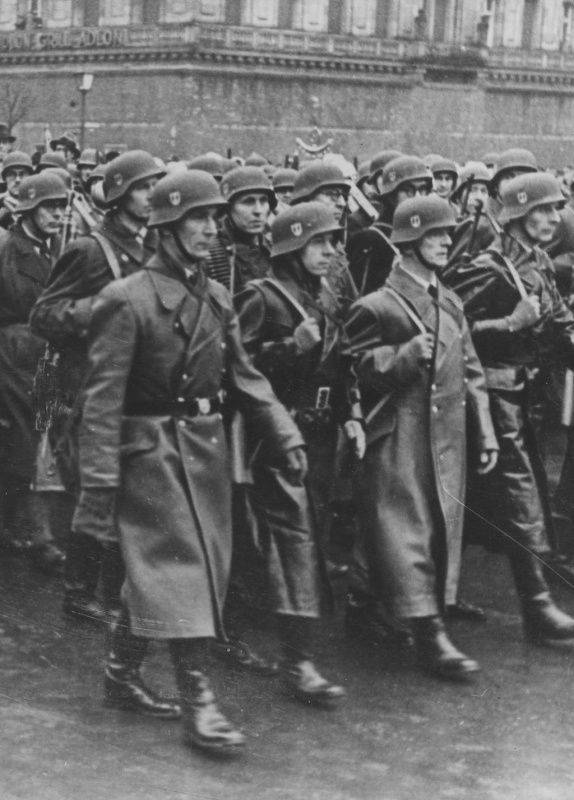
Parade of Folksturm militias in Berlin
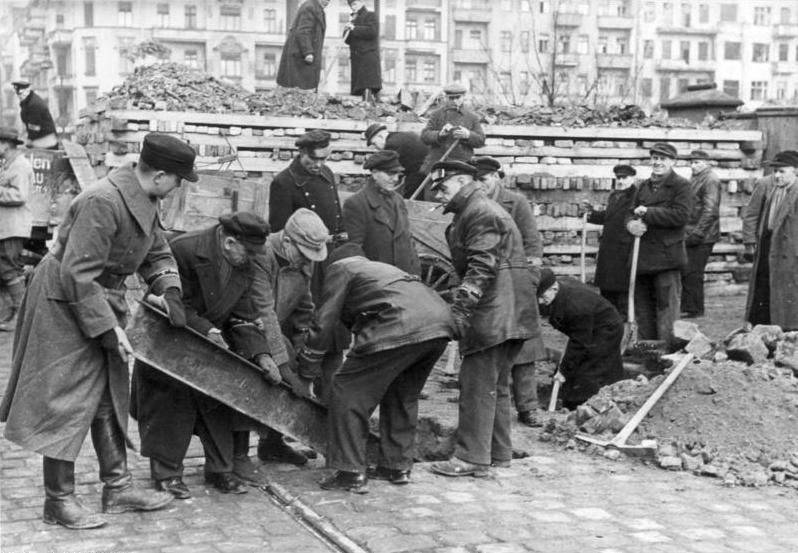
Volkssturm soldiers are building anti-tank barriers, Berlin
Special attention was paid to the central defense sector (sector No. 9). It housed various central state, party and military institutions. Among them was the Reichstag and the imperial office. It was the "heart" of the Third Reich. Therefore, during the battle for Berlin, the central sector became the site of especially fierce and fierce fighting. It was here until recently that the remnants of the Berlin garrison and selected SS units defended themselves. Here sat down the leaders of the Reich. Here over the dome of the Reichstag soared Victory Banner.
After Berlin itself was a huge city that had about 600 thousand buildings. It was extremely difficult to take such a city, although the Soviet troops during the storming of Budapest, Vienna, Königsberg already received a great experience of urban fighting. Here every quarter, street and house needed to be taken by storm, paying a bloody price for the victory. For our soldiers, on the one hand, it was the last and main battle, they took by storm the "den of the beast." On the other hand, everyone knew that Victory was near, to die, and to lose comrades was especially hard.
The defense of Berlin was organized on the basis of the fierce street fighting. Hitler and his entourage were going to fight to the last, they were not going to give up. The troops were ordered to defend the capital to the last man and the last bullet. The military and political leadership of the Third Reich, even in conditions of utter senselessness, refused to capitulate and made the last sacrifice - tens and hundreds of thousands of people still had to die in order for peace to finally come to Europe.
Thus, at the end of the war, our troops needed to solve a difficult task. To break through the Oder-Neisen defensive line (from three lanes) with a total depth of 20-40 kilometers, which ran along serious natural lines, had a well-prepared defense system and many cities and towns turned into nodes of resistance. It was necessary to break the resistance of the millionth Berlin group (army of the army group "Vistula" and "Center"), in which the best divisions of the Third Reich were concentrated. It was necessary to crush such a tough nut as the Berlin fortified area.
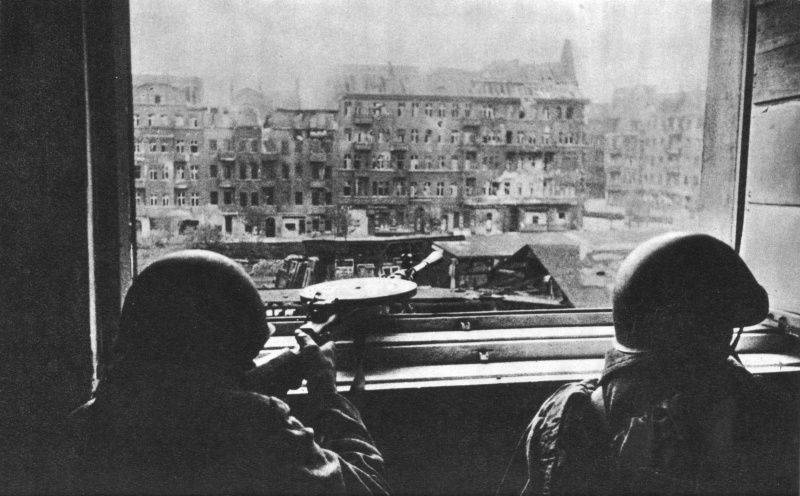
Soviet soldiers during the storming of Berlin
To be continued ...
Information